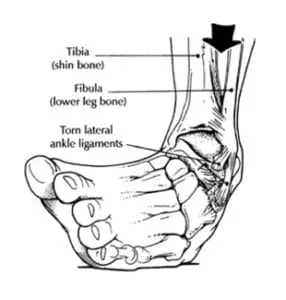ANKLE SPRAIN
Ankle Sprain
 Ankle sprains are about as common as shopping carts at the grocery store. Take a wrong step, walk on uneven ground, or be active in athletics, and sooner or later, you will probably have an ankle sprain. By definition, an ankle sprain is a type of injury involving some degree of ligamentous trauma, be it over stretching, partial rupture, or total tear. Along with this ligament injury is some level of ankle joint instability, which can become an invitation for future reinjury and weakness. Ankle sprains usually involve either the inside or outside aspects with the outer variety being the much more prevalent type due to its weaker structures and greater tendency for injury. The typical presentation of an ankle injury is acute pain, swelling, bluish-black bruising or discoloration, loss of motion, and one’s inability to weight-bear without discomfort. A thorough examination by a specialist is recommended in order to rule out other problems such as fractures, tendon ruptures, and discolorations.
Ankle sprains are about as common as shopping carts at the grocery store. Take a wrong step, walk on uneven ground, or be active in athletics, and sooner or later, you will probably have an ankle sprain. By definition, an ankle sprain is a type of injury involving some degree of ligamentous trauma, be it over stretching, partial rupture, or total tear. Along with this ligament injury is some level of ankle joint instability, which can become an invitation for future reinjury and weakness. Ankle sprains usually involve either the inside or outside aspects with the outer variety being the much more prevalent type due to its weaker structures and greater tendency for injury. The typical presentation of an ankle injury is acute pain, swelling, bluish-black bruising or discoloration, loss of motion, and one’s inability to weight-bear without discomfort. A thorough examination by a specialist is recommended in order to rule out other problems such as fractures, tendon ruptures, and discolorations.
The actual cause of an ankle sprain is trauma that creates excessive strain, stretching or tension on the inherent ligamentous structures resulting in subsequent injuries and disability. The ankle joint will only move so far and then something has to give. In certain isolated cases, a bone will fracture but in the vast majority of cases, a ligament is over stretched, partially tears, or totally ruptures. Pain is the unmistakable common denominator with simple weight-bearing often becoming an impossible task. The trained specialist in his or her examination will be able to largely assess the degree of injury, the probable mechanism of injury, and the chances for partial to total recovery.
The treatment approach to a sprained ankle is largely determined by how soon after the injury it is seen. Assuming that we are dealing with a fresh injury seen within hours to a few days of the trauma, our first line of treatment should be directed at reducing the soft tissue swelling. Immobilizing the injury site is used to limit unnecessary motion along with rest, elevation, ice, and compression to reduce the pain. Physical therapy and rehabilitation are then used to reestablish ankle joint stability and strength. Orthotics and braces are sometimes used for the purpose of supporting the foot and ankle while reducing any allowable abnormal range of motion. Surgery is occasionally used to strengthen the ankle joint ligaments in those cases involving chronic instability and a frequent history of sprains. Too often under addressed ankle sprains lead to a laxity of the ankle anatomy and recurrence of these ankle sprains can become more frequent.
PLEASE NOTE:
The information contained in this article is not intended to provide advice for individual problems, nor to substitute for professional advice or care from a physician. For answers to specific questions concerning your personal circumstances, you should consult your physician directly.
